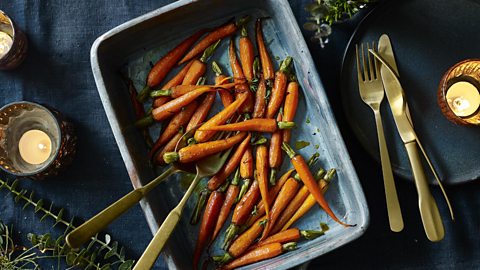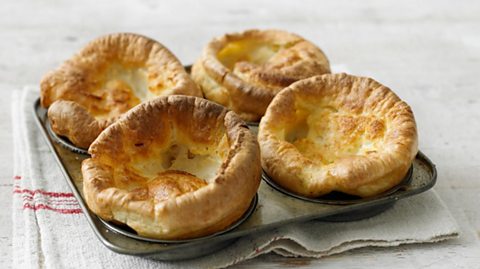"I’ve prepped my Christmas dinner and it's not even December"
If you’re in charge of Christmas dinner this year and have resigned yourself to slaving over dozens of dishes for your family, we’re here to tell you there is another way. That is, if you like being prepared.

Kate Hall, a home cooking consultant and food waste advocate, thinks that the risks of food shortages, price rises, self-isolation and a general loathing of washing up mean it's worth getting in early on the Christmas food preparation. Really early.
“I’ve prepped my 2021 Christmas dinner, and it’s not even December. I’ve got two small meat joints, a turkey crown, a gammon, pigs in blankets, stuffing balls, potatoes, parsnips, carrots, Brussels sprouts, cauliflower, white sauce, broccoli and green beans,” she said. And it all fits in one deep drawer, thanks to her top freezer organisation.
“I first pre-prepared Christmas dinner in 2020 in the event we couldn’t visit family, where we were planning on having our meal,” said Kate. “Having the backup in the freezer gave me peace of mind that Christmas wouldn’t be ruined if we needed to isolate, or if we couldn’t get a delivery slot close to Christmas,” she added.
This year she’s hosting the family meal and wants to spend as little time in the kitchen as possible on the big day. She’s got the Christmas dinner cooking time down to just two hours, with a minimum of washing up. “I’ll turn the oven on around 11 o'clock and we’ll eat around 1 o'clock,” she said.
Kate's tips on getting ahead can save you time too, if you've got the freezer space.

The potatoes
If you make roast potatoes between now and the 25th December, par-boil twice the amount you need and freeze the extras so they're ready to cook from frozen on Christmas Day.
“I peel, chop and boil the potatoes for five minutes,” said Kate, who then shakes the pan to fluff up the edges, drizzles over oil and spreads the potatoes out onto a baking tray to cool completely. Put the whole tray in to freeze for one to two hours, with the potatoes separated so they don’t stick together, then transfer them to a reusable sealed bag freezer bag.
On Christmas Day, heat a tablespoon or two of oil or goose fat in a roasting tray until it’s piping hot. Carefully add the frozen potatoes with some optional rosemary and whole garlic cloves (which can both be frozen too!) and bake as normal, for around one hour at 190C/170C Fan.
Give vegetables the chop
Who wants to be chopping carrots on Christmas Day when there's presents to open and carols to sing? “All of the veg is peeled, chopped and blanched before freezing, but it's not cooked,” said Kate. Blanching means putting the vegetables into boiling water for 1-2 minutes before cooling them quickly in iced water. This process helps the vegetables retain their colour, texture and taste when they are frozen. The vegetables are spread on to baking trays, frozen, then popped into sealed bags.
“The carrots and parsnips will be honey-roasted,” she said. On Christmas Day, she will toss the root veg in salt, pepper honey and oil before roasting until soft, sticky and caramelised, around 45 minutes. The root veg can also be steamed if you don’t have room in your oven.
Broccoli and green beans can be boiled or steamed from frozen, but you should reduce the cooking time by how long they were blanched for. “Roasting frozen Brussels sprouts is best,” said Kate, as boiling can give a soggy, chewy result. “Don't defrost the vegetables,” says Kate, as fruits and vegetables are much better cooked from frozen.
Sublime sides
Arguably, the best part of the Christmas dinner is the most work. The variety and number of side dishes is a matter of personal taste, but quite a few can be organised ahead so you have maximum flavours and leftovers.
Yorkshire puddings freeze really well. Of course, you can buy them ready frozen, but there is nothing like a homemade Yorkshire made to your liking. After cooking a batch, cool them on a wire rack so they don't get soggy. Freeze on a tray, then stack the puddings and store in a sealed bag. Just pop the frozen Yorkshires on to a hot oven tray for 5-10 minutes before serving.
Make-ahead stuffing can be frozen as balls, loose in a bag or in a freezer-to-oven dish. If you want to stuff the bird, defrost the stuffing overnight in the fridge. Sage, onion and sausage stuffing balls can be cooked from frozen alongside the bird or on a tray. If you’re looking for a veggie stuffing, this one without the sausage is for you.
Cauliflower cheese is a huge favourite for many, but seems like quite a lot of effort to make on Christmas morning. Not for Kate Hall, who makes and freezes a white sauce ahead. Defrost the sauce in the fridge overnight, then stir in frozen cauliflower florets and put straight in the baking dish, topping with grated cheese. Bake until bubbly, hot and golden-brown.
Christmas red cabbage is one of those dishes that tastes even better when made ahead of time. Freeze after making and defrost overnight before heating through on the hob or in the microwave.
Pigs in blankets can be wrapped and frozen before cooking.Most sausages can be cooked from frozen, just check the packet for instructions. If you buy them from a butcher, bake alongside the roast potatoes until crisp outside and piping hot, (the centre should be at least 70C for two minutes).
The meat
You can buy frozen turkey, or freeze a fresh one yourself. “I get turkey crowns as they fit in the freezer and fridge easier,” said Kate. “I’ve also got a small gammon in the freezer ready to be defrosted and cooked,” she said.
You can also freeze cooked ham, sliced, popping baking paper between each slice to stop it sticking together. You shouldn’t refreeze ham after it’s been defrosted, so bring on the sandwiches.
The best way to freeze uncooked meat is in its original packaging. If it’s not well-wrapped, wrap in clingfilm and then kitchen foil and place in an air-tight freezer bag, squeezing out as much air as you can to avoid freezer burn. Turkey and gammon need to be thoroughly defrosted before cooking, ideally in the bottom of your fridge. For a turkey, you'll need to allow 8 to 12 hours per kilogram. It could take a couple of days so make sure you get it out in time!
For turkey and other Christmas meat cooking instructions, use our roasting calculator.
Essential sauces
Making gravy from scratch might be a matter of minutes after the roast is finished, but making good gravy starts with a good stock. Use the giblets to make turkey gravy, or visit your butcher to score some chicken carcasses or beef bones, depending on your Christmas main course. Cooking stock is easy in a slow-cooker or pressure cooker, and only requires hands-off time on the hob. Defrost the stock overnight in the fridge and use in your gravy with all those tasty roasting tin bits. You can go the whole way and freeze our make-ahead Christmas gravy recipe.
Cranberry sauce can be kept in the fridge for a week or frozen if made further in advance. It tastes even more delicious when the flavours are left to mingle for a while. If freezing, defrost in the fridge for 24 hours before serving.
Sweet stuff
For deliciously festive make-ahead mince pies, it’s best to freeze them raw in a bun tray (pop them out into a box when they’re solid) and then cook them, back in the bun tray, from frozen. Just increase the cooking time of your frozen mince pies by 5 minutes.
Christmas cake and Christmas pudding can be kept for months without freezing. It's best to make these early to feed with alcohol, such as brandy, and allow the flavours to develop.
Freezing dos and don'ts
“Between 8C and 63C is referred to as the ‘food danger zone’," said Kate, when bacteria can rapidly multiply. If you have cooked something and are not planning to eat it immediately, "you need to cool it quickly and get it into the fridge or freezer within two hours. Do not put hot food in the fridge or freezer though, as it will raise the temperature and put other food at risk," she said.
Defrost food on a plate at the bottom on the fridge and then use within 24 hours of it being defrosted. You can also defrost food in the microwave, if you have an adaquate defrost setting (make sure you remove any packaging). Follow the manufacturing instructions and you need to cook microwaved-defrosted food immediately, as it is in the danger zone temperature. If you're unsure, refer to the Food Standards Agency guide.



